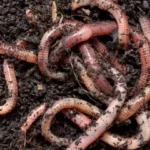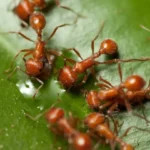You’re not alone if you’re tired of seeing your garden devastated by Japanese beetles each year. Many gardeners face the frustrating task of combating these persistent pests that can ruin plants. This guide provides a proven, eco-friendly solution that can help protect your garden without harsh chemicals by utilizing beneficial nematodes for Japanese beetles.
Beneficial nematodes, particularly those of the species Heterorhabditis bacteriophora, are highly effective in controlling Japanese beetle populations. These microscopic, soil-dwelling nematodes target the larvae, also known as grubs, of Japanese beetles. These larvae live in the soil and feed on the roots of grass and other plants. When applied to the soil, these nematodes actively seek out the grubs, entering their bodies through natural openings.
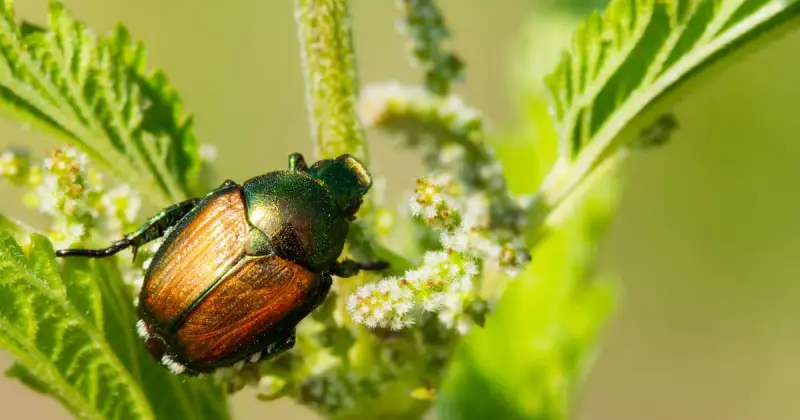
Read on to discover how beneficial nematodes can be a crucial ally in maintaining the health of your garden. You’ll uncover the secret life and lifecycle of these fascinating and nearly invisible critters, how they specifically target Japanese beetles and the best practices for applying them to ensure maximum effectiveness. This natural solution helps manage pests and supports a balanced garden ecosystem.
Humble Highlights
- Save time by uncovering how beneficial nematodes can help curb Japanese beetle swarms eating your backyard garden AND how nematodes can stop their larvae so you can promote healthier plants and help protect your budding crops!
- Discover the differences between nematodes and traditional chemical pesticides and why nematodes provide a low-maintenance and cost-effective option so you can reduce pest populations without the need for harsh synthetic alternatives.
- Save time with these 4 vital points regarding nematode effectiveness on beetles and how to apply nematodes efficiently – even if it’s your first time – so you can provide long-term pest control, reducing the need for repeated pesticide applications.
Understanding Beneficial Nematodes
Beneficial nematodes, such as Heterorhabditis bacteriophora, are microscopic organisms that are natural predators of various insects, including Japanese beetles. These nematodes excel in controlling grubs, the larvae stage of many harmful insects like Japanese beetles. Heterorhabditis bacteriophora, in particular, is highly effective in this role, enhancing pest management strategies.

Applying beneficial nematodes to control Japanese beetles requires precise timing. The optimal period for application is mid-to late August, especially during overcast or rainy weather, which maximizes their effectiveness.
These nematodes arrive in their infectious juvenile stage and can be stored in the refrigerator for up to three weeks before use. Various application techniques, such as using sponges, gels, granules, or liquids, provide flexibility in addressing specific infestation areas. 1
Life Cycle Of Japanese Beetles
Beneficial nematodes effectively manage Japanese beetles by targeting crucial stages of their development. Understanding how these beetles progress through their life cycle is vital to controlling their population.
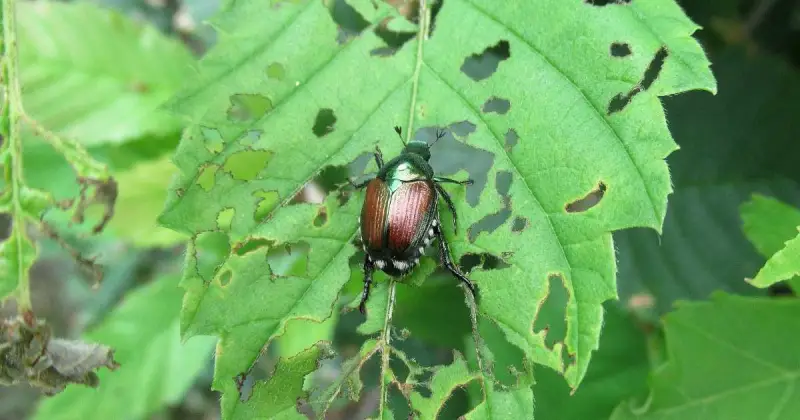
The life cycle of a Japanese beetle has four primary stages: egg, larval, pupal, and adult. The cycle starts when adult beetles deposit eggs in the soil.
After hatching, the larvae, also known as white grubs, consume grass roots, damaging lawns and gardens. These grubs then transition into the pupal stage within the soil, subsequently emerging as adult beetles. 2
Adults damage plants by feeding on their leaves, flowers, and fruit. Employing beneficial nematodes to attack the larvae and grubs at the soil surface proves a successful strategy for reducing the number of Japanese beetles.
| Life Stage | Description | Vulnerability |
|---|---|---|
| Egg | Deposited in soil by adults | Low |
| Larvae (Grubs) | Consume grass roots, damaging vegetation | High |
| Pupal Stage | Transitional phase in soil | Medium |
| Adult Beetles | Eat leaves, flowers, and fruit | Low |
Effectiveness Of Nematodes On Grubs
Nematodes are highly effective in controlling the larval and white grub stages of various beetle species, including Japanese beetles. These nematodes provide gardeners and farmers with an organic and sustainable pest control method.
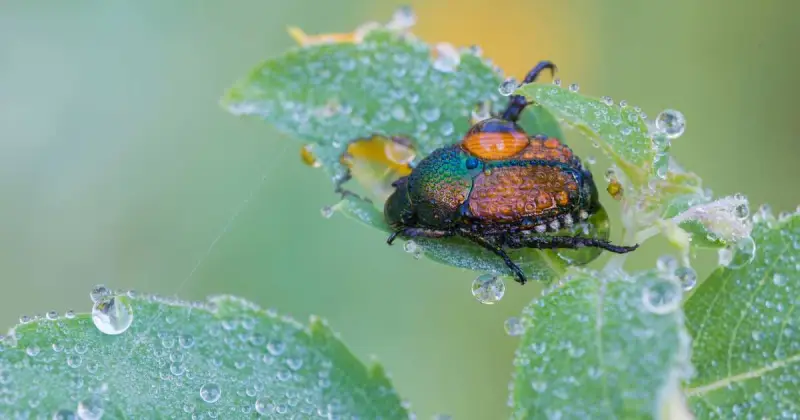
Here are some important points regarding the use of nematodes against grubs:
- Beneficial nematodes excel at locating and managing Japanese beetle larvae and white grub stages, offering an eco-friendly pest management option.
- The infective juvenile stage of nematodes penetrates the larvae, releasing bacteria that lethally infect the host insects.
- Nematodes parasitize Japanese beetle grubs, significantly lowering their numbers and promoting biological control. 3
- Their reproduction within the host ensures a prolonged effect on grub populations, aiding in ecosystem stability and enhanced vegetation health.
Once inside the grub, Heterorhabditis bacteriophora nematodes release symbiotic bacteria that multiply rapidly, producing toxins that kill the host within a few days.
The nematodes reproduce inside the dead grub, eventually emerging to seek new hosts. This biological control method is particularly beneficial because it targets the larvae stage of the Japanese beetle, reducing the number of adults that emerge to damage plants.
Application Methods For Nematodes
Nematodes can be applied using various methods, including sponges, gels, granules, or liquid formulations, to target Japanese beetle grubs effectively. Selecting the appropriate application method depends on your specific garden conditions and preferences. Sponges or gels are recommended for targeted treatment, while granules or liquid solutions are better options for wider area coverage.
For optimal results with beneficial nematodes, apply them during dusk or under overcast/rainy conditions to protect them from UV damage. It’s advisable to moisten overly dry soil before applying the nematodes. Considering the weather conditions, the most effective time to target Japanese beetles is from mid to late August. 4

Benefits Of Using Nematodes
Nematodes present a viable, natural alternative to synthetic pesticides when evaluating methods to control Japanese beetles. Here are some advantages of employing beneficial nematodes against Japanese beetles:
- Efficiency in Larval Targeting: Beneficial nematodes attack Japanese beetles during their larval stage, interrupting their development into adult beetles where they can inflict the most damage to plants and trees.
- Eco-Friendly Pest Management: Utilizing nematodes avoids using chemicals, providing an environmentally safe option for reducing Japanese beetle numbers.
- Sustainable Control: Nematodes can reproduce within their beetle hosts, maintaining their population control effect over time.
- Cost-Effective Application: Beneficial nematodes are applied at 25-100 million per 1,000 square feet, making this method effective and economical for controlling Japanese beetle populations. 5
By incorporating beneficial nematodes into your pest management strategy, you can effectively reduce Japanese beetle populations and protect your plants from damage in an environmentally sustainable way. Take a few minutes to watch the video below, which explains what nematodes are and how these invisible helpers work hard for you!
Nematodes vs. Chemical Pesticides
Selecting beneficial nematodes over chemical pesticides offers a more sustainable method for managing Japanese beetles. Chemical pesticides, while effective in eliminating these pests, also pose risks to non-target species such as ladybugs and earthworms.
Beneficial nematodes, however, provide a targeted solution that spares these beneficial organisms and preserves the environment. This approach allows for effective pest control while supporting the balance of the ecosystem.
In contrast to chemical pesticides, which can upset the ecosystem’s balance by harming beneficial organisms, beneficial nematodes serve as a safer, more sustainable option for pest control. They specifically target pests like Japanese beetles without negatively affecting other species, making them an ideal choice for those seeking eco-friendly pest management solutions. 6
Opting for nematodes rather than chemical pesticides promotes a healthier, more stable ecosystem and ensures effective long-term pest management without compromising the environment’s health.

Nematodes For Organic Pest Control
Using beneficial nematodes is highly effective against Japanese beetles for organic pest control. Here are some important considerations when implementing nematodes for pest management:
- Heterorhabditis bacteriophora Nematodes: These nematodes specifically target Japanese beetles, offering a focused and natural method for pest suppression.
- Symbiotic Bacteria: They carry bacteria that help exterminate pest larvae, enhancing the control strategy’s efficiency.
- Natural Predation: After infiltrating the pest larvae, nematodes reproduce, generating offspring that continue targeting and infecting new pests, thus ensuring sustained control. 7
- Application Guidelines: For best results, administer 25-100 million nematodes per 1,000 sq ft under temperatures between 55°F and 85°F.

Tips For Successful Beetle Management
To manage beetles effectively, adopt a comprehensive strategy using beneficial nematodes targeting Japanese beetles. Apply these nematodes from mid to late August for optimal results, as they’re more effective than chemical pesticides in controlling this stubborn pest.
It’s crucial to store the nematodes in a refrigerator for 2-3 weeks before use to ensure they remain active. For maximum effectiveness, deploy the nematodes during overcast or rainy conditions to protect them from UV light damage. The best application times are at dusk or amid rainfall. 8
Adhering to these guidelines regarding timing, storage, and environmental conditions will enhance your ability to control Japanese Beetles sustainably.
Beneficial nematodes can fight back against Japanese beetles through their ability to disrupt the soil microbiome in favor of beneficial microorganisms. When nematodes such as Heterorhabditis bacteriophora infect Japanese beetle grubs, they release symbiotic bacteria (typically from the genus Photorhabdus) that kill the grubs and produce compounds that suppress harmful soil pathogens.
These beneficial bacteria can outcompete pathogenic microbes for resources and space, creating a more favorable environment for beneficial soil organisms.
This microbial shift can indirectly affect the Japanese beetle population by enhancing the health and resilience of plants, making them less attractive and more resistant to pest attacks.
Subsequently, healthier plants can better withstand and recover from the beetle’s destructive feeding damage, reducing the overall impact of any surviving Japanese beetles. The improved soil health also fosters a more robust ecosystem where natural predators and other beneficial organisms can thrive, contributing to a more integrated and sustainable pest management approach.
Conclusion
Beneficial nematodes offer a natural and highly effective method for combating Japanese beetles in your garden. Impressively, a single nematode has the potential to eliminate up to 230 beetle grubs during its lifespan.
This approach helps control these destructive pests and preserves the health of your plants and soil, supporting a thriving ecosystem. Opting for nematodes over chemical pesticides also safeguards other beneficial insects that contribute to the overall vitality of your garden.
Remember, by choosing this eco-friendly solution, you’re making a conscious decision to nurture and sustain the natural balance of your garden environment.
Have you used nematodes to fight against swarming Japanese beetles invading your turf? We’d love to know your story and which nematode species you used. Please take a moment, leave a comment below, and give us the 411!
SOURCES
- National Library Of Medicine, National Center For Biotechnology Information – Susceptibility Of The Adult Japanese Beetle, Popillia Japonica To Entomopathogenic Nematodes
- Wikipedia – Japanese Beetle
- Maine.gov – Using Beneficial Nematodes For Grub Control
- National Library Of Medicine, National Center For Biotechnology Information – Entomopathogenic Nematode Production And Application Technology
- University Of Florida – Benefits Of Nematodes In Healthy Soil Ecosystems
- United States Environmental Protection Agency – Pesticides
- Springer – Nematodes
- University Of Minnesota, Extension – Japanese Beetles In Yards And Gardens


